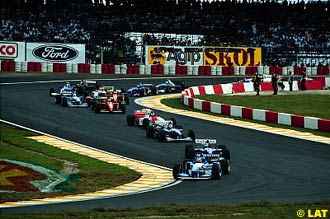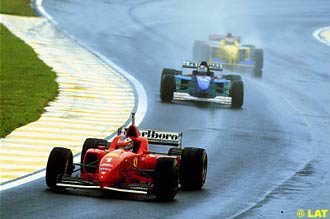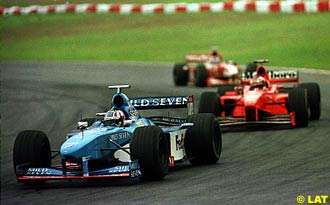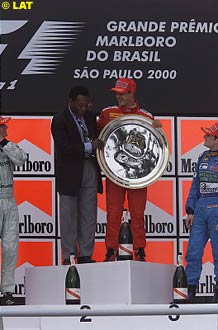| ATLAS F1 Volume 7, Issue 13 | |||
 |
Focus: Michael Schumacher at Interlagos | ||
| by Marcel Schot, Netherlands | |||
|
Prior to every race, Marcel Schot will focus on one driver, one track: the relationship between the human being and tarmac. This week, we review Michael Schumacher's past at Interlagos
On the eve of the Brazilian Grand Prix in which Michael Schumacher could equal Alberto Ascari's seven consecutive wins record, it's interesting to take a look at Schumacher's past performances on the bumpy Brazilian track.
The Benetton driver then continued into the first qualifying session at the same speed, moving up to third place. While Riccardo Patrese was somewhat struggling in the second Williams, "only" a second ahead of the German, Nigel Mansell grabbed provisional pole by a margin rarely seen in Formula One. The Briton lapped Interlagos in 1:15.703, a massive 1.8 seconds faster than his teammate and 2.8 seconds faster than Schumacher. However, Schumacher wasn't the biggest surprise of the day: Pierluigi Martini grabbed that honour by putting his Dallara in fourth.
On Saturday morning, Schumacher didn't have a very good session, which continued in the afternoon qualifying session. With the McLarens finally at full speed after suffering numerous problems before the second qualifying session, Schumacher got demoted to fifth in the session, with a time just a little slower than he did in the first qualifying session. Even though the majority of the drivers improved their qualifying time, only Senna and Berger in their McLarens passed the German on the grid. So after a good warm-up, in which he finished third again, it was time for Michael Schumacher's first race at Interlagos.
Before the race had even started, Schumacher moved up a place. After the formation lap before the race, Gerhard Berger turned into the pits instead of taking his position on the grid. The Austrian McLaren driver had problems with an overheating engine and was forced to start from the pitlane. At the start, the Williamses were away, only to be seen again when they lapped the field. Meanwhile, Schumacher got entangled in a fierce duel with Ayrton Senna and Jean Alesi, with Schumacher's teammate Martin Brundle close behind. With Mansell and Patrese running away by two seconds every lap, third would be as good as victory for the rest of the field. Senna, running on home ground, was barely able to keep Schumacher behind him.
However, after 12 laps the duel between the triple World Champion and the future triple World Champion ended when Senna's electronics started acting up. The Brazilian dropped back to sixth, ran one more fast lap, before his car finally gave up. Around this time, Schumacher finally was able to create some breathing room between himself and Alesi. When Schumacher pitted after 23 laps, he was around four seconds ahead of the French Ferrari driver. However, once the pitstops were completed, it became clear that Alesi wasn't able to continue to keep the pace up. After 30 laps he collided with Martin Brundle, causing the Briton to retire and Alesi to pit before resuming his race. This put Schumacher in a comfortable position to take his second consecutive third place.
At the same time, Michael Schumacher was surprised by a lightning start by Jean Alesi, who darted past the German from ninth place. Unlike the previous season, only one of the two Williamses were running away from the field, as Damon Hill had to cope with Ayrton Senna. Schumacher moved ahead of Alesi quickly and after ten laps saw Damon Hill overtaking Ayrton Senna's underpowered McLaren. After 25 laps, Senna also fell victim to Schumacher. What followed soon after was a tropical shower of enormous proportions.
Quite a few drivers were caught by surprise, like in this year's Malaysian Grand Prix. Among them were Japanese drivers Aguri Suzuki and Ukyo Katayama, as well as Christian Fittipaldi and runaway leader Alain Prost. As a result the safety car came onto the track, nullifying the gaps between the cars. When the race resumed, Damon Hill grabbed the lead, before Ayrton Senna passed Hill a few laps later and went on to claim victory in his home Grand Prix. Schumacher, however, had to pit and dropped back a long way. This wasn't the end of his race though, as Schumacher battled hard and ran at a consistently high pace to claim third place in the end.
As 1994 arrived, the world was looking forward to the clash of the titans, the old versus the new: Senna vs Schumacher. Ayrton Senna, now at Williams, immediately got off to a great start. On Friday morning the Brazilian was a full second ahead of Schumacher, who in turn was a second ahead of the rest of the field, surprisingly led by Arrows driver Christian Fittipaldi. However, after the first qualifying session, the battle was much closer and Senna's gap over Schumacher decreased to just two tenths of a second. On Saturday the same ritual repeated itself; Senna was a second ahead in practice and three tenths in qualifying. After four sessions, it was very clear that this was a battle among two giants. The closest anyone else got during the two days was Damon Hill, Senna's teammate, who got within six tenths of Senna in the second practice session.
When the race started on Sunday, Schumacher's weakest moment arrived. At the start, Jean Alesi once again got the better of him, Schumacher dropping back to third. It took a few laps for Schumacher to pass the Frenchman to take back second place. Meanwhile, Senna was in the lead and had been slowly increasing the gap to the field. When Michael Schumacher finally got past Alesi, he pushed hard immediately, fearing Senna was already too far away. However, the German really got going and took the lead after both drivers made their first pit stop. All Senna could do was follow. Once the race reached the three quarter point, Senna pushed a little harder. As it happened, the Brazilian pushed a bit too hard. After 55 laps, he was coming out of the final slow corner before going onto the straight, when the triple World Champion hit the throttle a little too early and spun, stalling the engine in the process. With Damon Hill a long way behind, Schumacher cruised to his first Brazilian victory with ease.
In 1996, Schumacher took on the challenge of driving for Ferrari. Everything showed that Ferrari in 1996 was nowhere near Benetton in 1994 and 1995. In qualifying, Schumacher was only able to grab fourth place right at the end of the session, a long way behind Damon Hill and only barely ahead of Jean Alesi, Martin Brundle and Mika Hakkinen. For the third year in a row Alesi had a superb start at Interlagos and beat Schumacher into the first corner. What followed must have been very frustrating for the reigning World Champion.
After 17 laps he even had to let Sauber driver Heinz-Harald Frentzen past for a short while. 24 laps down, Schumacher headed into the pits as one of the first drivers to make a pit stop. After that and Jacques Villeneuve's retirement, the German slowly made his way into the top six, before his second stop on lap 40 threw him back to eighth place. However, after the second set of pitstops was over, Schumacher found himself in third position. For a while, the German battled with crowd favorite Rubens Barrichello in the Jordan, but the Brazilian was too eager to score well for his home crowd and left the track while trying to outbrake Schumacher. After the retirement of Barrichello, Schumacher took a safe third place, almost a lap behind second place finisher Alesi.
1997 presented us with the only year without Michael Schumacher on the podium at Interlagos. In qualifying, he was able to stay fairly close to Jacques Villeneuve, but the race showed a helpless Ferrari with much too little grip to battle the Williams. At both the original start and the restart, the German was able to outperform the Canadian polesitter, but the long straights saw Schumacher passed more than once. A long way behind the eventual winner, Schumacher battled for fourth with Hakkinen and Alesi. In the end the Finn, the German and the Frenchman finished within a second of each other, but over 30 seconds behind winner Villeneuve.
The next year, Williams domination had ended. However, it wasn't Ferrari domination that had taken over, like Schumacher and all of Italy had hoped. The ones ahead of the field were McLaren again. In each and every session Mika Hakkinen was first with David Coulthard second. In the race, the German once again dropped a place at the start, not to Jean Alesi but to Michael's teammate Eddie Irvine. After ten laps the orders at Ferrari become clear; Irvine easily let Schumacher by to take his fourth place.
In 1999 Schumacher was finally competitive in the Ferrari. Although he never led the times, things worked out fine on race day. After starting from fourth, surprisingly behind Stewart driver Rubens Barrichello, Schumacher got his first break before the race started. On the grid, McLaren's David Coulthard engine stalled, forcing him to start from the pitlane. Then a few laps into the race, the leading McLaren of Mika Hakkinen developed a gearbox problem, causing Mika Hakkinen to drop back behind Schumacher. The German was now between Barrichello and Hakkinen. Luckily, Barrichello's two stop strategy brought an end to the first battle, but Mika Hakkinen proved too tough a nut to crack. The McLaren was faster than the Ferrari, and after the pitstops Hakkinen was able to retake the lead and ultimately the win. Schumacher was only four seconds behind, unlike the previous two years when the Ferrari driver was over a minute behind.
Last year, Schumacher's march with Ferrari to Brazil's top step was finally completed. Not through a display of power, but rather due to Mika Hakkinen's problems. The Finn had been faster all weekend, so when Schumacher led the race early, there was speculation that the McLarens were on a different strategy, which proved to be correct. Hakkinen was in the lead of the race when after 30 laps he suddenly slowed and entered the pitlane, driving straight into the box and retired. Although Schumacher was happy with the victory and the resulting 20 point lead over the McLarens in the championship, he said he'd rather have raced the McLarens to the end.
The bottom line: 9 entries, 8 podiums, 3 wins. With the Schumacher/Ferrari combination growing stronger every year since 1996, we can expect a lot from the German this year. After six consecutive wins from pole, the World Champion seems pretty much unbeatable at the moment and with a few of his favorite circuits coming up, he looks ready to challenge Ascari's record.
|
| Marcel Schot | © 2007 autosport.com |
| Send comments to: schot@atlasf1.com | Terms & Conditions |
 In 1992 the German visited Interlagos for the first time in his Formula One career. The newest revelation of the Grand Prix world immediately gained respect by being faster than triple World Champion and crowd favorite Ayrton Senna in the first session on Friday, while still using the old Benetton B191B chassis. While the Williams team was outclassing the competition by miles from the start - Nigel Mansell was fastest, almost two seconds faster than the first non-Williams - Schumacher set an impressive fourth fastest time, just ahead of Senna and behind the even more surprising Andrea de Cesaris in the Tyrrell.
In 1992 the German visited Interlagos for the first time in his Formula One career. The newest revelation of the Grand Prix world immediately gained respect by being faster than triple World Champion and crowd favorite Ayrton Senna in the first session on Friday, while still using the old Benetton B191B chassis. While the Williams team was outclassing the competition by miles from the start - Nigel Mansell was fastest, almost two seconds faster than the first non-Williams - Schumacher set an impressive fourth fastest time, just ahead of Senna and behind the even more surprising Andrea de Cesaris in the Tyrrell.
 In 1993, Schumacher's weekend was more of a slow build up, with fifth in the first qualifying session and fourth in the second session, behind the Williamses of Prost and Hill and Ayrton Senna's McLaren. When the race began, Schumacher had no idea what happened behind him, as Michael Andretti collided with Gerhard Berger at the end of pit straight, ending both drivers' races. Behind that, Brundle and Minardi driver Barbazza also collided, bringing down the field from 26 to 22 cars within seconds.
In 1993, Schumacher's weekend was more of a slow build up, with fifth in the first qualifying session and fourth in the second session, behind the Williamses of Prost and Hill and Ayrton Senna's McLaren. When the race began, Schumacher had no idea what happened behind him, as Michael Andretti collided with Gerhard Berger at the end of pit straight, ending both drivers' races. Behind that, Brundle and Minardi driver Barbazza also collided, bringing down the field from 26 to 22 cars within seconds.
 A year later, Schumacher repeated the feat, but this time the competition of the Williamses of Damon Hill and David Coulthard was a little more fierce. At the start the German grabbed the lead, but after the first set of pitstops, Damon Hill came out on top. However, just a few laps later the Briton's rear suspension failed, sending the unfortunate driver into a spin and out of the race. After that, Schumacher was in the lead and apart from a short while between his pitstop and Coulthard's, there was nothing to worry about. In the end Schumacher made a third stop and finished eight seconds ahead of the Scotsman.
A year later, Schumacher repeated the feat, but this time the competition of the Williamses of Damon Hill and David Coulthard was a little more fierce. At the start the German grabbed the lead, but after the first set of pitstops, Damon Hill came out on top. However, just a few laps later the Briton's rear suspension failed, sending the unfortunate driver into a spin and out of the race. After that, Schumacher was in the lead and apart from a short while between his pitstop and Coulthard's, there was nothing to worry about. In the end Schumacher made a third stop and finished eight seconds ahead of the Scotsman.
 The first set of pitstops didn't bring much for Schumacher either. He passed Williams pilot Frentzen, but ended up behind Benetton's Alexander Wurz, who was on a one stop strategy. Only when Wurz finally came in for his pitstop after 46 laps was Schumacher able to move into a podium position, albeit a long way behind the McLarens. His second stop allowed him to retain his third position safely, so after 72 laps, Schumacher finished on the podium for the fifth time in six attempts.
The first set of pitstops didn't bring much for Schumacher either. He passed Williams pilot Frentzen, but ended up behind Benetton's Alexander Wurz, who was on a one stop strategy. Only when Wurz finally came in for his pitstop after 46 laps was Schumacher able to move into a podium position, albeit a long way behind the McLarens. His second stop allowed him to retain his third position safely, so after 72 laps, Schumacher finished on the podium for the fifth time in six attempts.